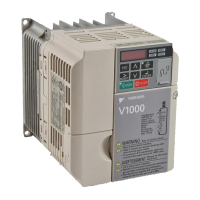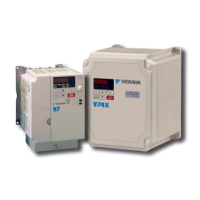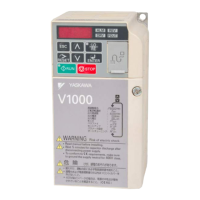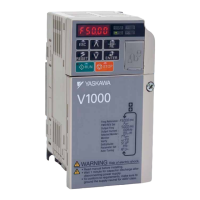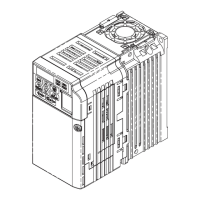When the digital input assigned in step 2 is off, terminal A1 is the frequency reference input. If it is closed, the A2 input value becomes the frequency
reference. The active acceleration / deceleration times are used for the change-over between the values
Drive
A1
A2
Main Frequency Reference
(voltage input)
Aux Frequency Reference 1
AC
S5
Frequency Reference Common
Multi-Function Digital Input
SC
Digital Input Common
2 kohm
+ V (+10.5 V, 20 mA)
2 kohm
(voltage input)
Figure 4.14 Switching between Main/Auxiliary Frequency References
n
Pulse Train Input: b1-01 = 4
Setting b1-04 to 4 programs the drive so that the frequency reference is provided by the pulse train control circuit input terminal RP.
Configuring the Drive for Pulse Train Frequency Reference Input
Setting up the Pulse Input (RP) as frequency reference input:
1.
Set the reference source to pulse input (b1-01 = “4”).
2.
Set the pulse train input to be the frequency reference by programming parameter H6-01 = “0” and programming the pulse train input gain to 100%
(H6-03 = “100”).
3.
Set the pulse input scaling (H6-02) to the input frequency value which is equal to the max. frequency reference value.
4.
Apply a pulse signal to the input and check that the reference value is the desired value.
5.
Readjust the pulse input gain and bias if necessary.
Note: 1. If the frequency display reaches the maximum desired frequency before the maximum pulse reference signal is applied, increase the pulse train input scaling value (increase
H6-02).
2. If the frequency display never reaches the desired maximum with the maximum pulse reference signal applied, decrease the pulse train input scaling value (reduce H6-02)
The pulse input has the following specifications. Ensure the pulse signal meets these specifications:
Pulse Train Input Specifications
Response Frequency
0.5 to 32 kHz
Duty Cycle 30 to 70%
High Level Voltage 3.5 to 13.2 V
Low Level Voltage 0.0 to 0.8 V
Input Impedance 3 kΩ
u
Run Command Input Selection: b1-02
This section explains how to assign the run command input.
Parameters b1-01 and b1-02 can be used to select the source of the run command and the frequency reference independently, e.g. set the reference from
the operator and set the run command from the terminals.
WARNING! Sudden Movement Hazard. When the run command is given by turning on the power to the drive, the motor will begin rotating as soon as the drive is powered up. Be
sure to take proper precautions if using this setting. Ensure the area around the motor is safe. Failure to comply could result in death or serious injury.
n
Run the Drive at 6 Hz using the Digital LED Operator: b1-02 = 0
To assign the run command to the operator panel, set parameter b1-01 to “0”. This will set up the drive to acknowledge the run command through the
LED operator. Initialize the run command using the Run and Stop keys. Upon power up, the drive uses parameter b1-02 to determine the run command
location.
The following procedure indicates how to start and stop the drive through the LED operator after parameter b1-02 has been set to 0.
Note:
When b1-02 (Run Command Selection) is not set to 0 (operator), press
to set LOCAL.
Step Display/Result
1. Turn on the power to the drive. The initial display appears.
2.
Set the frequency reference to F6.00 (6 Hz).
Note: Refer to Drive Mode Details on page 62 for instructions on how to set the frequency reference.
3.
Press the
RUN
key to start the motor.
4.6 Basic Drive Setup Adjustments
YASKAWA ELECTRIC SIEP C710606 18A YASKAWA AC Drive – V1000 Technical Manual (Preliminary)
77
4
Start-Up Programming
& Operation

